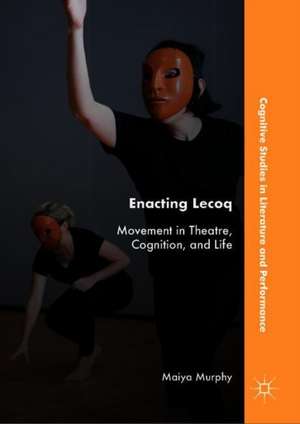Enacting Lecoq: Movement in Theatre, Cognition, and Life: Cognitive Studies in Literature and Performance
Autor Maiya Murphyen Limba Engleză Hardback – 10 ian 2019
Din seria Cognitive Studies in Literature and Performance
-
 Preț: 303.28 lei
Preț: 303.28 lei -
 Preț: 299.96 lei
Preț: 299.96 lei - 8%
 Preț: 537.27 lei
Preț: 537.27 lei -
 Preț: 302.20 lei
Preț: 302.20 lei -
 Preț: 299.34 lei
Preț: 299.34 lei -
 Preț: 301.10 lei
Preț: 301.10 lei -
 Preț: 381.98 lei
Preț: 381.98 lei -
 Preț: 392.37 lei
Preț: 392.37 lei -
 Preț: 386.81 lei
Preț: 386.81 lei - 15%
 Preț: 644.18 lei
Preț: 644.18 lei -
 Preț: 393.52 lei
Preț: 393.52 lei - 18%
 Preț: 784.92 lei
Preț: 784.92 lei - 15%
 Preț: 640.88 lei
Preț: 640.88 lei -
 Preț: 384.86 lei
Preț: 384.86 lei - 15%
 Preț: 647.08 lei
Preț: 647.08 lei - 15%
 Preț: 698.62 lei
Preț: 698.62 lei - 18%
 Preț: 730.02 lei
Preț: 730.02 lei - 15%
 Preț: 586.88 lei
Preț: 586.88 lei - 15%
 Preț: 528.13 lei
Preț: 528.13 lei - 15%
 Preț: 587.02 lei
Preț: 587.02 lei - 18%
 Preț: 725.26 lei
Preț: 725.26 lei - 18%
 Preț: 725.26 lei
Preț: 725.26 lei - 18%
 Preț: 730.97 lei
Preț: 730.97 lei - 15%
 Preț: 699.77 lei
Preț: 699.77 lei - 15%
 Preț: 640.88 lei
Preț: 640.88 lei
Preț: 584.43 lei
Preț vechi: 687.56 lei
-15% Nou
Puncte Express: 877
Preț estimativ în valută:
111.84€ • 121.45$ • 93.95£
111.84€ • 121.45$ • 93.95£
Carte tipărită la comandă
Livrare economică 22 aprilie-06 mai
Preluare comenzi: 021 569.72.76
Specificații
ISBN-13: 9783030056148
ISBN-10: 3030056147
Pagini: 205
Ilustrații: XVII, 214 p. 1 illus.
Dimensiuni: 148 x 210 x 21 mm
Greutate: 0.43 kg
Ediția:1st ed. 2019
Editura: Springer International Publishing
Colecția Palgrave Macmillan
Seria Cognitive Studies in Literature and Performance
Locul publicării:Cham, Switzerland
ISBN-10: 3030056147
Pagini: 205
Ilustrații: XVII, 214 p. 1 illus.
Dimensiuni: 148 x 210 x 21 mm
Greutate: 0.43 kg
Ediția:1st ed. 2019
Editura: Springer International Publishing
Colecția Palgrave Macmillan
Seria Cognitive Studies in Literature and Performance
Locul publicării:Cham, Switzerland
Cuprins
1. Introduction.- 2. Crafting Necessary Temptations and Needful Freedoms: Lecoq’s Actor-Instructor Relationship.- 3. Enacting Cognitive and Creative Foundations.- 4. Lecoq’s Mime and the Process of Identifications: Enacting Movement, Selfhoods, and Otherness.- 5. Significant Practices and Principles: Play, Improvisation, Mask Work, and Language.- 6. Conclusion: “Beautiful, beautiful, but where are you going?”.
Recenzii
“Compared to other texts in the field of theatre, Murphy’s Enacting Lecoq is unique both in its Enactivist approach and the way in which it focuses on the foundational versus executional abilities of the actor-creator. … it could be a hugely important text for graduate students in Theatre Education, Movement Pedagogy, Applied Theatre, as well as acting teachers, whose students will deeply benefit from an incorporation of Murphy’s insights into their pedagogy.” (Jordan Rosin,Theatre Topics, Vol. 31 (1), March, 2021)
Notă biografică
Maiya Murphy is a scholar, teacher, creator, and performer. She is Assistant Professor in the Theatre Studies Programme at the National University of Singapore. She has written on Lecoq pedagogy, cognitive science, collective creation, physical theatre approaches, and dance. She also makes theatre with her collective, Autopoetics.
Textul de pe ultima copertă
This book examines the theatrical movement-based pedagogy of Jacques Lecoq (1921-1999) through the lens of the cognitive scientific paradigm of enaction. The conversation between these two both uncovers more of the possible cognitive processes at work in Lecoq pedagogy and proposes how Lecoq’s own practical and philosophical approach could have something to offer the development of the enactive paradigm. Understanding Lecoq pedagogy through enaction can shed new light on the ways that movement, key to Lecoq’s own articulation of his pedagogy, might cognitively constitute the development of Lecoq’s ultimate creative figure – the actor-creator. Through an enactive lens, the actor-creator can be understood as not only a creative figure, but also the manifestation of a fundamentally new mode of cognitive selfhood. This book engages with Lecoq pedagogy’s significant practices and principles including the relationship between the instructor and student, identifications, mime, play, mask work, language, improvisation, and movement analysis.
Caracteristici
Offers a sustained analysis of Lecoq pedagogy Makes a contribution to the further advancement of interdisciplinary discussions between the humanities and cognitive sciences Highlights movement, as opposed to embodiment, in cognitive and creative processes
